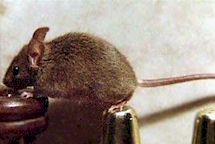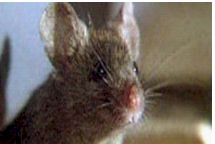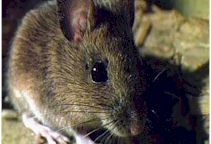| Common Name |
House Mouse |
| Scientific Name |
Mus musculus |
| Size |
Adult are 12-30g and the tail is 60-105mm |
| Colour |
Brown to black, belly fur white, brown or grey. The colour of
the tail is lighter below than above. |
| Description |
House mouse is a small, slender rodent that has a slightly pointed
nose, small, black, protruding eyes; large sparsely haired ears and a
nearly hairless tail with obvious scale rings. |
| Habitat |
They are specially found in areas that are near human
habitats and open fields
House mice live in houses; out buildings, stores, and other structures.
In favourable conditions, feral mice may be found in fields, along water
courses and in place with dense vegetation where they can hide in. These
feral animals make runways through the grass. House mouse is regularly
found along irrigation ditches where irrigation is practiced, in
agricultural areas.
|
| Lifecycle |
House mouse has an extremely high breeding potential with the female
house mouse becoming sexually mature at six weeks. After mating,
gestation lasts 19-21 days and immediately after giving birth, mating is
possible. In ideal conditions a mouse can give birth every 25 days.
|
| Disease Transmitted |
Lymphocytic choriomeningitis (LCM)
|
| Symptoms |
An initial phase may last for a week. It begins with any one of the
following; fever, lack of appetite, muscle pains, headache, nausea, and
vomiting. Other symptoms that seldom appear include sore throat, cough,
joint pain, chest pain, testicular pain, and parotid (salivary gland)
pain. After a few days of recovery, the second phase of the disease
occurs, consisting of symptoms of meningitis (for example, fever,
headache, and a stiff neck) or characteristics of encephalitis (for
example, drowsiness, confusion, sensory disturbances, and/or motor
abnormalities, such as paralysis). LCMV has also causes acute
hydrocephalus (increased fluid on the brain). In rare instances,
infection results in myelitis (inflammation of the spinal cord) and
presents with symptoms such as muscle weakness, paralysis, or changes in
body sensation. An association between LCMV infection and myocarditis
(inflammation of the heart muscles) has been suggested. During the
first phase of the disease, the most common laboratory abnormalities are
a low white blood cell count (leukopenia) and a low platelet count
(thrombocytopenia). Liver enzymes in the serum may also be mildly
elevated. After the onset of neurological disease during the second
phase, an increase in protein levels, an increase in the number of white
blood cells or a decrease in the glucose levels in the cerebrospinal
fluid (CSF) is usually found. |
| Type of Damage |
- When house mice live in or around buildings, they almost always
cause some degree of economic damage. In homes and commercial buildings,
they may feed on various stored food items or pet foods. They usually
contaminate foodstuffs with their urine, droppings, and hair. On farms,
they may cause damage to feed storage buildings and feed transporting
equipment. A single mouse eats merely about 3 grams of food per day (3.6
kg per year) but it considerably destroys more food than it consumes
because of its habit of biting off small bits on many foods and
discarding partially eaten items.
- House mice living in fields may dig up and feed on newly planted
grain, or may cause some damage to crops before harvest There are great
losses in stored food. They are notorious of damage containers and
packaging materials in warehouses where food and feeds are stored. Much
of this loss is due to contamination with droppings and urine, making
food to be injurious to human health.
- House mice cause structural damage to buildings by their biting on
persistently and nest-building activities. In livestock lairages and
similar structures, they may readily cause severe damage to insulation
inside walls and attics. Such damage also occurs in homes, apartments,
offices, and commercial buildings but usually at a slower rate because
in such buildings mouse populations are small. House mice often lodge in
large electrical appliances, and here they may chew up wiring as well as
insulation material, resulting in short circuits which create fire
hazards or other malfunctions that are costly to repair. Mice may also
damage stored items in attics, basements, garages, or museums, zoo.
Damaged family heirlooms, paintings, books, documents, and other such
items may be impossible to replace.
|
| Sources / Breeding |
Mus musculus is identified by remarkable reproductive
potential. Breeding occurs throughout the year. The oestrous cycle is
4-6 days long, with oestrus lasting less than a day. Females experience
a postpartum oestrus 12-18 hours after giving birth. Females generally
have 5-10 litters per year if conditions are favourable. Gestation is
19-21 days but may be extended by several days if the female is
lactating. Litters consist of 3-12 (generally 5 or 6) offspring, which
are born naked and blind. They are fully furred after 10 days, open
their eyes at 14 days, are weaned at 3 weeks, and reach sexual maturity
at 5-7 weeks. Average life span is 6 years. |
| Prevention |
There are two ways that one could employ to prevent house mouse
infestation
- Sanitation
Even if the area is very small and has limited amounts of food
and shelter mice can survive. Consequently, no matter how good the
sanitation, most buildings in which food is stored, handled or used
will have an impact on the house mice infestation if not
mouse-proofed. Nonetheless good sanitation will not often eliminate
mice; poor sanitation is sure to attract them and will allow them to
develop drastically. Good sanitation will also reduce the adequacy
of food and shelter for mice. Thus good house-keeping is of
paramount importance in the endeavours of house-mouse prevention.
- Mouse-proof construction
One of the most profitable ways of house mouse prevention is to
"build them out" by eliminating all openings through which they can
enter the building. All places where food is stored, processed or
used should be made mouse-proof. Dried grain and meat products
should be stored in glass jars, metal canisters or sealable airtight
containers.
Seal any openings larger than 6.35mmto keep mice out of the
building. Steel wool mixed with sealing compound makes a good plug.
Patching material needs to be smooth on the surface to prevent mice
from pulling out or chewing through the patching compound. Seal
cracks and openings in building foundations and openings for water
pipes, vents and utilities with metal or concrete. Doors, windows
and screens should be tightly fitting. It may be necessary to cover
the edges with metal to prevent gnawing. Plastic sheeting or screen,
wood, rubber or other chewable materials are not good for plugging
holes used by mice.
|
| Control |
- Traps
Trapping is an effective control method for mus musculus. It is
the most preferred control method if there are few rats in the
building. Trapping has several advantages: (1) Trapping is the most
safe control method compared to hazardous chemicals used to control
house mouse, (2) it permits the user to make sure that the mouse has
been killed and (3) it allows for disposal of the mouse dead body,
It prevents the presents of offensive smell that occur if chemicals
are used in the building.
The simple, cost effective wood-based snap trap is more efficient.
Bait traps with peanut butter, chocolate candy, dried fruit or a
small piece of bacon tied securely to the trigger. Set them so that
the trigger is sensitive and will spring easily. Set traps close to
walls, behind objects, in dark corners and in places where one can
easily trace mouse. Traps are placed so that mice will pass directly
over the triggers as they follow the natural course of travel,
usually close to a wall. Traps can be set on ledges or on top of
pallets of stored materials if mice are active in such locations.
Use enough traps to eliminate the rodents quickly. (Using too few
traps is a common error by individuals attempting to control mice.)
Mice not often travel far from their shelter and food supply, so
traps are placed no more than 10 feet apart in areas where mice are
active. Leaving traps unset until the bait has been taken at least
once (pre-baiting) often makes trapping to be succinctly done. Glue
boards are used as an alternative, which catch and hold mice
attempting to cross them. Glue boards are placed along walls where
mice travel. Two or three glue boards placed side-by-side will be
more effective than individual boards. Do not use them where
children, pets. Glue boards should be placed in places that are dust
free. Glue traps should be used under moderate temperatures.
- Poison baits (Rodenticides)
Rodenticides are one of the most effective methods of
controlling house mouse (mus musculus). Purchasing unlabelled
rodenticides from the street vendors should be avoided. Rodenticides
are a last resort because they endanger human health, thus trapping
is advocated. Since these baits are poisonous, it is ones
responsibility to ensure that these chemicals are registered. When
fumigation is going to be conducted, one should make sure that it is
done by a registered person or organization and check for
credentials.
Fresh bait should be place continuously since the house mouse might
take about a week to die. Bait should be placed in hidden places so
as to prevent bait shy.
|







